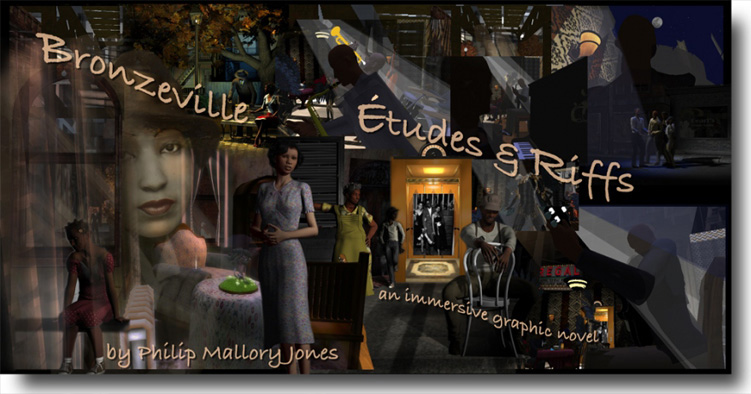|
Welcome to
a critical review of virtual culture |
|||||
| click on these links for: | Features | BLOG | Editorials | Contact | |
|
Welcome to
a critical review of virtual culture |
|||||
| click on these links for: | Features | BLOG | Editorials | Contact | |
|
Bronzeville Etudes & Riffs Moves from Second Life® to Unity3 Platform 
BRONZEVILLE In a major expansion of concept, artist Philip Mallory Jones has moved the development of Bronzeville Etudes &: Riffs onto the Unity 3 game development platform, which will make it available on web browsers and on portable devices that use the iOS and Android operating systems. He now calls this work an immersive graphic novel. Open it and you step into the Chicago South Side and experience life there as a Black American from the turn of the 20th century to the 1950s. |
||
|
Jacque Quijote is the avatar of artist Philip Mallory Jones in the Second Life® virtual world. We selected the work of Jacque Quijote In the Sweet Bye & Bye as a "Pick of the Week" in May, 2007, and featured this work in our 2007 print monograph, The Second Life Art World. Five years later I asked the artist about these developments: |
AWM: Had you always visualized it as an "immersive graphic novel"? or when did that concept hit you?
Mr. Jones has also written an extensive illustrated essay on his development of immersive technology art, beginning with his first Heathkit quartz crystal radio receiver as a youth in the 1950s. It is required reading for anyone interested in the creative process. The
essay, "First
Life to Second Life: Notes on the Design and Development of a
Synthetic World Installation, In The Sweet Bye & Bye: An
Immersive Memoir:" can be read online. Philip
Mallory Jones was Artist in Residence at
Ohio University's Aesthetic Technologies Lab when he created In The Sweet Bye & Bye.
His current work-in-progress advances the development of narrative immersive space, and is a quintessential example of the artistic exploration of virtual technology. Click on the image above and read all about it. Then immerse yourself in it. === Free
ArtWorld Market Report Download: |
|
©2016 ArtWorld Market